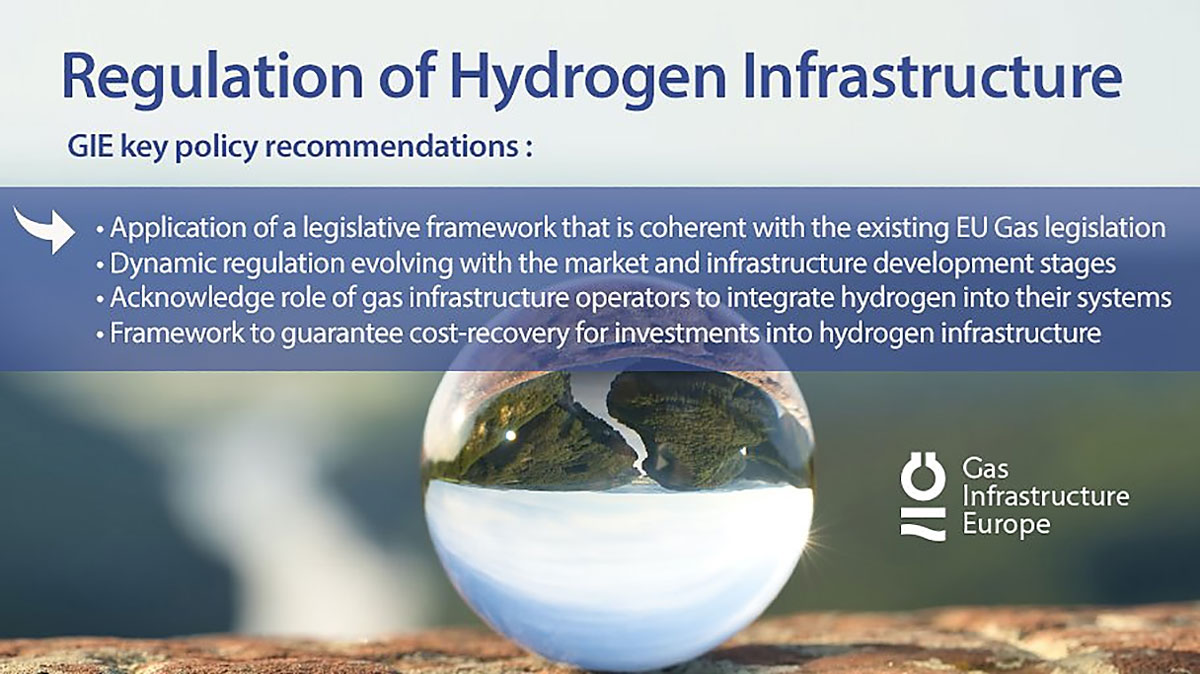GIE Setting Out Future Hydrogen Infrastructure
The regulation of the future hydrogen infrastructure is at the core of today’s energy debates, GIE publishes a position paper presenting the views and recommendations of its 70 members from 27 European countries.
This paper outlines clear policy recommendations that will boost the establishment of the hydrogen economy. It also presents the unique benefits of the gas infrastructure in integrating hydrogen. Gas Infrastructure Europe (GIE) represents around 70 members from 27 European countries that own and operate the existing infrastructure, which is ready to be retrofitted and/or repurposed for transporting, storing, and importing hydrogen. With the already acquired expertise, the gas infrastructure operators can build and operate new dedicated hydrogen infrastructure in safe conditions. Within the context of upcoming EU legislation, GIE presents policy recommendations to enable the gas infrastructure to efficiently integrate hydrogen, thereby contributing to the targets of the EU Green Deal.
“Gas infrastructure operators are very well-equipped to integrate hydrogen into their systems. If we want to deliver climate neutrality by 2050 and achieving the targets of the EU Hydrogen Strategy, we need a very well-developed infrastructure for hydrogen. The existing gas infrastructure can offer that. Building on the existing gas network guarantees safe transport, storage and import of hydrogen. It also keeps the costs low for society and brings benefits to the whole energy system,” Boyana Achovski, Secretary-General of GIE, states.
Benefits of the existing gas infrastructure
The introduction of hydrogen will need a well-developed infrastructure. The gradual hydrogen market ramp-up and demand will lead to an increasing need to transport, store, import and export large volumes of hydrogen in its various forms. Different pathways will thereby exist for each Member State: Besides newly built infrastructure for hydrogen where it is cost-effective, the existing gas infrastructure is very well-suited to integrate hydrogen by retrofitting and repurposing pipelines, storage facilities and LNG terminals. Large cost- and time savings for society as well as minimising the need for constructing new types of energy infrastructure will increase the social acceptance of the energy transition.
The existing infrastructure will be progressively made available for hydrogen, compatible with the evolution of natural gas demand.
One possible pathway among many is blending hydrogen into the existing gas infrastructure up to a certain threshold. Besides enabling quick decarbonisation wins, hydrogen blending supports the building-up of hydrogen production capacity. Moreover, it also represents a cost-effective transitional solution in those European regions that do not have the capacity yet to immediately switch from natural gas infrastructure to hydrogen infrastructure.
The mostly well-developed pan-European gas pipeline and storage infrastructure of today allows a cost-effective transition to integrate hydrogen. It will enable the pan-European transport of hydrogen, connecting hydrogen supply and demand sites. The gas infrastructure delivers the flexibility needed to balance hydrogen supply and demand and to decarbonise the energy system.
Furthermore, it should be noted that a single hydrogen pipeline can transport 10-20 times more energy than an electricity cable, based on the same level of investments.
This means that a high-voltage electricity line could carry 1-2 GW of power, while the transport capacity of hydrogen pipelines lies between 15-30 GW4. As also outlined by the European Hydrogen Backbone Initiative, the transmission network is ready to integrate hydrogen in a cost-efficient way. The study underlines that repurposing the existing gas infrastructure is possible at 10-35% of the costs that would be required for a newly built hydrogen pipeline.
Moreover, it enables the connection between hydrogen supply and demand sites and thereby, a dedicated EU hydrogen infrastructure will develop gradually.
Hydrogen storage assets will facilitate the interlinkage between electricity and hydrogen markets and provide the flexibility needed to balance the entire energy system on short-term and seasonal timescales. Moreover, underground storage facilities can secure hydrogen supply by enabling large seasonal storage of renewable and low-carbon hydrogen. While salt caverns can be completely filled with hydrogen (no reactivity with salt rock), porous rock storage sites and aquifers can be retrofitted to blend hydrogen with natural gas. In the European Union (EU27), around 50 salt caverns are currently used for natural gas storage with a storage volume of more than 180 TWh.
These salt caverns are also highly suitable for hydrogen storage, as salt is one of the best sealing rocks available in the subsurface. Salt caverns, acquifers, and depleted fields can contribute to short-term flexibility needs that will increase in the coming decades and could have a theoretical storage capacity potential of 60 TWh hydrogen already today. Hydrogen storage in porous rock, such as aquifers or former gas or oil fields, is subject to additional research and pilot projects currently investigated by storage operators.
Storing hydrogen in underground gas storage sites is significantly cheaper than electricity storage. For example, hydrogen storage unit costs in salt caverns are at least a factor 100 cheaper than electricity storage cost in batteries. It is therefore an efficient solution for large scale renewable energy storage.
LNG terminals are well positioned to develop new services and contribute to the energy transition: they can be retrofitted and repurposed at lower costs compared to investments into new systems that enable both intra-EU and non-EU hydrogen imports and exports.
This underlines the EU Hydrogen strategy expectations of installing at least 40 GW of renewable hydrogen electrolysers by 2030 within the EU, and the industry expectations of building additional 40 GW renewable hydrogen electrolysers outside the EU, in the Eastern and Southern Neighbourhood, ensuring a sustained cross-border trade with the EU. Adapted terminals will have the capacity to receive different hydrogen-based energy carriers in liquid form from any origin in the world.
Therefore, they facilitate the import of renewable and low-carbon hydrogen that is produced outside Europe and then shipped to Europe as liquid hydrogen or as other hydrogen carriers like synthetic methane, ammonia or LOHC (Liquid Organic Hydrogen Carrier). Hydrogen shipment within Europe will also be needed.
As the hydrogen market matures, policy should ensure that hydrogen users can be supplied from a diverse supplier portfolio. This could involve supporting imports of hydrogen via LNG terminals and import pipelines from non-EU countries in addition to domestic production.
The benefits of the entire existing gas infrastructure show a complete picture where synergies exist due to the interconnections between pipeline, storage, and LNG infrastructure. Therefore, this well-developed and intertwined infrastructure system will guarantee the safe transport, storage and import of hydrogen.
GIE’s key policy recommendations
- Application of a legislative framework that is coherent with the existing EU Gas legislation
- Dynamic regulation evolving with the market and infrastructure development stages
- Acknowledge role of gas infrastructure operators to integrate hydrogen into their systems
- Framework to guarantee cost-recovery for investments into hydrogen infrastructure
“In order to kick-start the hydrogen market in the EU, an appropriate system to regulate the hydrogen infrastructure is needed. We think that the most efficient way is to build on the basic principles of the existing regulation for natural gas, while leaving Member States the flexibility to reflect on national and regional hydrogen characteristics. Now is the time to set the right regulatory framework that will enable a successful ramp-up of the hydrogen economy,” Ralph Bahke, Sponsor of GIE New Gases Area & CEO of ONTRAS Gastransport GmbH, explains.
“The regulation of hydrogen should recognise the advantages that the existing transmission, storage and LNG infrastructure have for developing the hydrogen infrastructure in a timely, cost-efficient and socially acceptable way and should facilitate the efficient planning, financing and operation of the infrastructure,” Michael Schmöltzer, Chair of GIE Hydrogen Regulation TF & Director of Uniper Energy Storage Austria, further explains.
About GIE
Gas Infrastructure Europe (GIE) is the association representing the interests of European gas infrastructure operators. GIE members are active in transmission, storage, and regasification via LNG terminals of renewable and low-carbon gases, including natural gas and hydrogen. Gathering around 70 industry entities from 27 European countries, GIE perfectly embodies the multiple transitional decarbonisation pathways of the EU regions. The association’s vision is that by 2050, the gas infrastructure will be the backbone of the new innovative energy system, allowing European citizens and industries to benefit from a secure, efficient, and sustainable energy supply.







